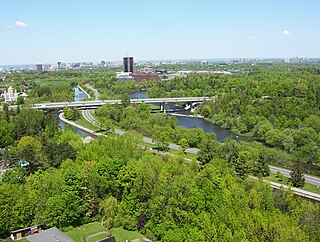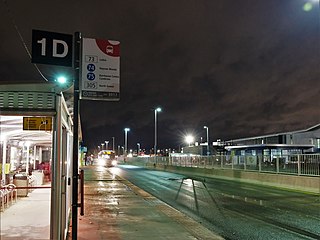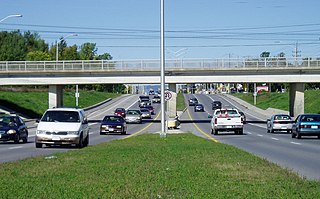Riverview is a neighbourhood in Ottawa, Ontario, Canada. It is southeast of the downtown adjacent to the Rideau River, its location on which is its namesake. The 2021 Census population of Riverview is 13,113.

The Rideau Centre is a three-level shopping centre on Rideau Street in Ottawa, Ontario, Canada. It borders on Rideau Street, the ByWard Market, the Rideau Canal, the Mackenzie King Bridge, and Nicholas Street in Downtown Ottawa. Over 20 million people visit the mall annually. It is the largest shopping mall in the National Capital Region and the sixth largest mall, by area, in Canada. The Rideau Centre complex has approximately 180 retailers and is connected to a rooftop park, a Westin Hotel, the Shaw Centre, the Freiman Mall and the Major-General George R Pearkes Building.

Sussex Drive, also known as Ottawa Regional Road 93, is an arterial road in Ottawa, Ontario, the capital of Canada. It is one of the city's main ceremonial and institutional routes. Travelling roughly parallel to the Ottawa River, Sussex Drive begins as a continuation of Sir George-Étienne Cartier Parkway at Rideau Gate, at the entrance to Rideau Hall. It travels south to Rideau Street, with the portion south of St. Patrick Street forming the northbound half of a one-way pair with Mackenzie Avenue. Both Mackenzie Avenue and Sussex Drive connect with Colonel By Drive at their southern end, which continues south alongside the Rideau Canal.

Nepean is a former municipality and now geographic area of Ottawa, Ontario, Canada. Located west of Ottawa's inner core, it was an independent city until amalgamated with the Regional Municipality of Ottawa–Carleton in 2001 to become the new city of Ottawa. However, the name Nepean continues in common usage in reference to the area. The population of Nepean is about 186,593 people.

Colonel By Drive is an 8.1 km (5.0 mi) long scenic parkway in Ottawa, Ontario, Canada.

Barrhaven is a suburb of Ottawa, Ontario, Canada. It is located about 17 km (11 mi) southwest of the city's downtown core. Prior to amalgamation with Ottawa in 2001, Barrhaven was part of the City of Nepean. Its population as of the Canada 2021 Census was 103,234.

Baseline is a public transit station directly across from the main campus of Algonquin College in Ottawa's west end, near the intersection of Woodroffe Avenue and Baseline Road. Many Algonquin College students and Centrepointe residents use this station to get to various points in the city, and to and from the college. Several residential and business areas such as Centrepointe and College Square are also served by this station.

Ottawa station, or Ottawa Train Station, is the main inter-city train station in Ottawa, Ontario, Canada, the capital of Canada. It is operated by Via Rail. It is located 4 kilometres (2.5 mi) east of downtown Ottawa and adjacent to Tremblay O-Train station in the neighbourhood of Eastway Gardens. The station serves inter-city trains connecting to Toronto, Kingston, Montreal and Quebec City on Via Rail's Corridor Route.

Woodroffe Avenue is a major north-south arterial road in Ottawa, Ontario, Canada's west end. It runs south from the Kichi Zibi Mikan through Baseline Road and Barrhaven to just short of Prince of Wales Drive near Manotick. The road runs through the heart of Nepean in Ottawa's west end. A satellite Via Rail station is also located at the intersection of Fallowfield Road.

The Central Experimental Farm (CEF), commonly known as the Experimental Farm, is an agricultural facility, working farm, and research centre of the Science and Technology Branch, formerly the Research Branch, of Agriculture and Agri-Food Canada. As the name indicates, this farm is centrally located in and now surrounded by the City of Ottawa, Ontario, Canada. Located on 4 square kilometres (1.5 sq mi) of land, the farm is a National Historic Site of Canada and most buildings are protected and preserved as heritage buildings.

Merivale Road is an arterial road in the west end of Ottawa, Ontario, Canada. It starts at Island Park Drive just north of Highway 417 and continues south until it ends at Prince of Wales Drive in Rideau Glen. South of Clyde Avenue, Merivale is known as Ottawa Road #17, while north of Clyde it is Ottawa Road #63.

The architecture of Ottawa is most marked by the city's role as the national capital of Canada. This gives the city a number of monumental structures designed to represent the federal government and the nation. It also means that as a city dominated by government bureaucrats, much of its architecture tends to be formalistic and functional. However, the city is also marked by Romantic and Picturesque styles of architecture such as the Parliament Building's Gothic Revival architecture.

The Constitution Building is an eleven-story office building in Ottawa, Ontario, Canada.

National Defence Headquarters (NDHQ) was created through the integration of the Canadian Armed Forces Headquarters with the civilian Department of National Defence (DND) staff in October of 1972. NDHQ is not a specific location, but is instead housed throughout a collection of offices in buildings across the National Capital Region, although it is most commonly identified with the Major-General George R Pearkes Building on Colonel By Drive in Ottawa.
The history of Ottawa, capital of Canada, was shaped by events such as the construction of the Rideau Canal, the lumber industry, the choice of Ottawa as the location of Canada's capital, as well as American and European influences and interactions. By 1914, Ottawa's population had surpassed 100,000 and today it is the capital of a G7 country whose metropolitan population exceeds one million.
The Department of National Defence is the department of the Government of Canada which supports the Canadian Armed Forces in its role of defending Canadian national interests domestically and internationally. The department is a civilian organization, part of the public service, and supports the armed forces; however, as a civilian organization is separate and not part of the military itself. National Defence is the largest department of the Government of Canada in terms of budget, and it is the department with the largest number of buildings.

National Defence Headquarters Carling, or NDHQ Carling, is a 148.79-hectare (367.7-acre) site containing federal government buildings near the Crystal Bay area in the west end of Ottawa, Ontario, Canada. The campus, located at the intersection of Carling Avenue and Moodie Drive, consists of 11 interconnected buildings with a total of 207,000 square metres (2,230,000 sq ft) of space.

Rideau is a station on the O-Train Confederation Line on Rideau Street on the border of the Sandy Hill and ByWard Market neighbourhoods in Central Ottawa, Ontario, Canada.
Colonel Michael David Calnan was a Canadian Forces officer notable as a serving military member given permission to run for political office while still on active duty.
















